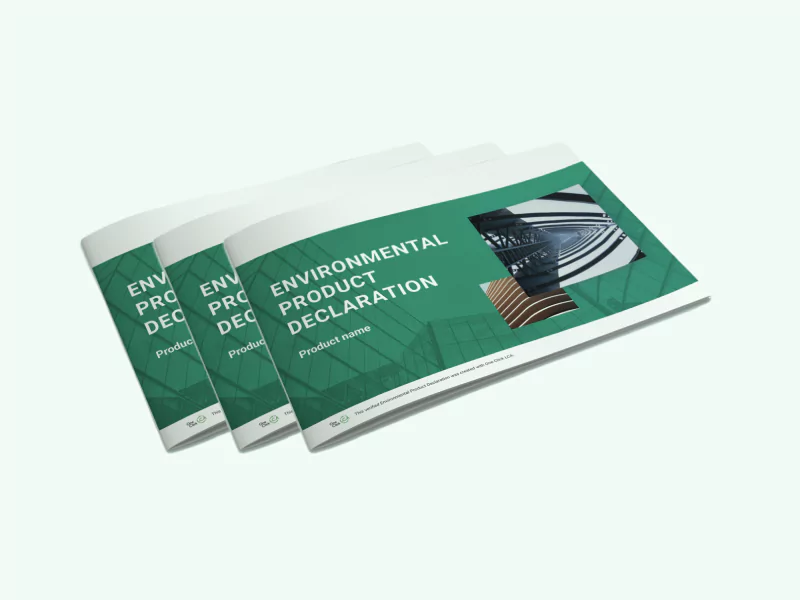
Source: One Click LCA
Learn all about EPDs — what they are and how you can use them to gain a competitive edge.
In today’s competitive business landscape, staying ahead often means more than just delivering quality products. It means aligning with the growing demand for sustainability. Environmental product declarations (EPDs) are a key tool for manufacturers to meet environmental expectations and gain a competitive edge. If you’re a manufacturer new to the concept of EPDs, this article will provide you with a simple, easy-to-understand explanation of what EPDs are, what they can be used for, and how they work.
Environmental Product Declarations (EPDs) — what are they?
Environmental product declarations, or EPDs, are standardized documents that provide information about the environmental performance of a product. They are a way to quantify and communicate the environmental impact of a product throughout its entire life cycle — from raw material extraction and manufacturing to distribution, use, and disposal.
EPDs are sometimes compared to nutritional labels for products, but instead of listing calories and ingredients, they present data on a product’s environmental footprint. This data includes factors like greenhouse gas emissions, energy consumption, water usage, and other environmental indicators.
Learn more about the different types of EPDs.
How can you use environmental product declarations?
Environmental product declarations serve multiple purposes for manufacturers, consumers, and stakeholders.
- Marketing and Product Benchmarking: When you create an EPD for your product, you can benchmark your product against other EPDs, which makes it easy for you to highlight how your product compares to competitors. This information can be used to bolster your marketing efforts and showcase your commitment to sustainability.
- Environmental Transparency: EPDs are a transparent and honest view of all aspects of a product’s lifecycle. This gives designers and manufacturers an opportunity to confidently communicate the environmental performance of their products to their clients. This transparency can help build trust with consumers and partners by demonstrating a commitment to sustainability.
- Product Comparison: EPDs enable consumers and businesses to compare the environmental impact of different products within the same category. This helps buyers make informed choices based on their environmental priorities.
- Sustainability Reporting: Many organizations require manufacturers to provide environmental data for their products as part of sustainability reporting or compliance with environmental regulations and ESG commitments. EPDs can be a valuable resource for meeting these requirements.
- Product Improvement: Manufacturers and designers can use EPDs to get a clear picture of their whole process, including logistical issues like supply chain management. This allows companies to optimize their process, create efficiencies, and save money, in addition to reducing environmental impacts.
- Market Access: In some cases, having EPDs can be a prerequisite for entering certain markets or securing contracts with environmentally conscious clients or governments. In the USA, for example, EPDs are required by state and federal Buy Clean initiatives for government procurement protocols.

Creating an environmental product declaration involves several key steps:
- Define your EPD Strategy: From determining which type of EPD you need, to whether to invest in-house or hire a consultant, you need to make some important decisions before you can get started.
- Choose a Program Operator and Product Category Rule (PCR): PCRs are a set of specific rules and guidelines that are established for a particular product category or group of products. They define how environmental impacts should be measured, what data should be collected, and how the information should be presented for that specific category of products. Think of them as your “recipe” for your EPD “cookbook”. A few examples are EPD Hub, IES, UL, and ASTM
- Life Cycle Assessment (LCA): The foundation of an EPD is a product life-cycle assessment. This assessment analyzes stages of a product’s life cycle, from raw material extraction to end-of-life disposal (also known as “cradle-to-grave”). It quantifies environmental impacts such as energy use, emissions, and resource consumption.
- Background Report: This provides additional insights into your LCA methodology, underlying assumptions, and the overall approach taken.
- Third-Party Verification: To ensure the accuracy and credibility of the EPD, it should be subject to third-party verification. You can verify your EPD easily by using tools like One Click LCA’s pre-verified EPD generator.
- Publication: Once verified, the EPD is published through a program operator and made available to the public, often through online databases and product labels.
What are the benefits of having an environmental product declaration?
EPDs offer a myriad of benefits for businesses, each with direct implications for your bottom line.
- Competitive Advantage: In today’s discerning marketplace, consumers and businesses alike are seeking eco-conscious products. EPDs can set your products apart by clearly and credibly demonstrating your commitment to sustainability and attracting environmentally conscious customers and partners.
- Market Expansion: As sustainability becomes a global priority, certain markets and clients may require EPDs as a prerequisite for entry or contract fulfillment. Having EPDs in your portfolio can open doors to these lucrative opportunities.
- Risk Mitigation: By thoroughly assessing and addressing your products’ environmental impacts, you can proactively mitigate potential risks related to regulatory compliance and reputation damage due to unsustainable practices.
- Operational Efficiency: EPDs offer insights into where your products have the most significant environmental footprint. Armed with this knowledge, you can optimize production processes and supply chains to reduce costs, resource consumption, and environmental impacts.
- Innovation Driver: EPDs can spark innovation within your organization, encouraging the development of more sustainable materials, processes, and products. This innovation can lead to cost savings and new revenue streams.
- Brand Enhancement: Transparently sharing EPDs can elevate your brand image, reinforcing consumer trust and loyalty. It positions your business as a responsible corporate citizen and paves the way for sustainable brand growth.
Environmental Product Declarations (EPDs) are powerful tools for manufacturers and other businesses to communicate the environmental impact of their products transparently and credibly. They serve various purposes, from helping consumers make informed choices to guiding sustainability improvements within a company. By harnessing the power of EPDs, you can elevate your brand, reduce risks, and unlock new opportunities for sustainable growth.
At One Click LCA, we make it easy for manufacturers to create environmental product declarations — whether you have one product, or a wide range of products, we have the tools you need. Get started by talking to an EPD expert today.


